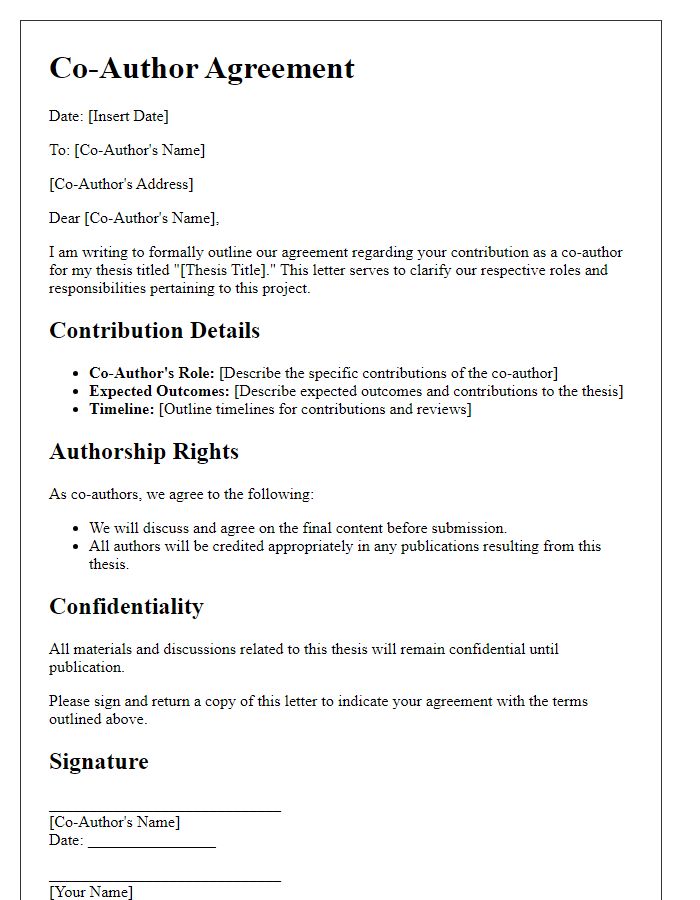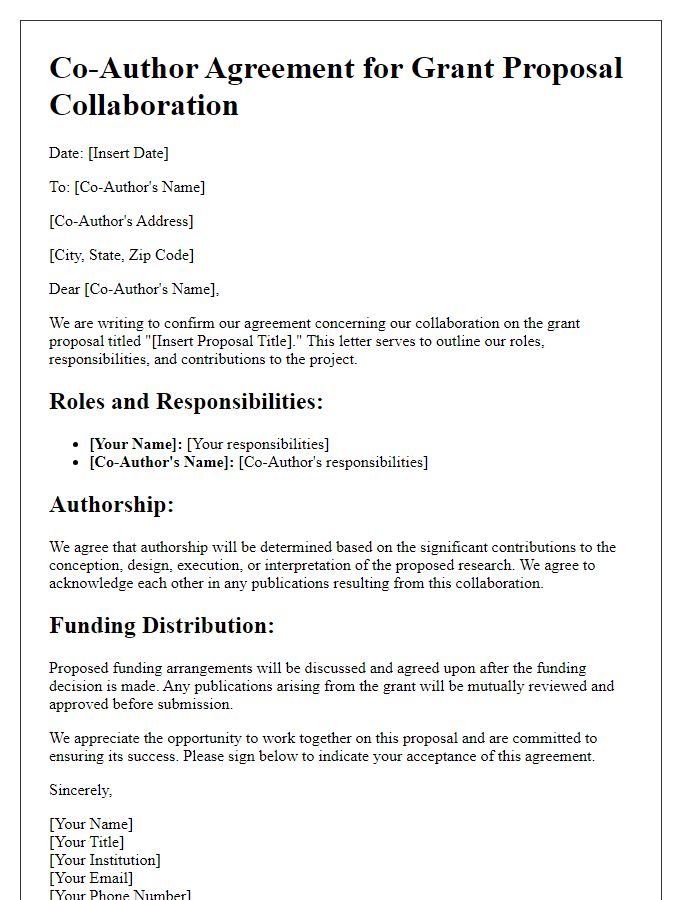Are you looking to collaborate on an exciting writing project with a fellow author? A co-author agreement is essential to ensure clarity and understanding between you and your writing partner. In this article, we'll explore the key elements to include in your co-author agreement, making the process smoother and more enjoyable for both parties. So, grab a cup of coffee and let's dive into the details that will help you create a solid foundation for your creative collaboration!

Purpose and Scope of Collaboration
Co-author agreements play a crucial role in defining the purpose and scope of collaboration in academic or research projects. A comprehensive agreement clearly outlines the objectives, such as contributing to a joint manuscript for publication in a peer-reviewed journal, and delineates the specific roles of each co-author, ensuring there is no ambiguity regarding tasks like data collection, analysis, and writing responsibilities. Furthermore, it should address the distribution of credit, such as authorship order based on contributions, and the responsibilities for addressing feedback from reviewers or handling revisions. Clear communication protocols must be established, detailing methods for updates and discussions, which can enhance productivity and align expectations. Additionally, considerations around intellectual property rights and publication timelines can prevent potential conflicts and keep the team focused on achieving shared research goals.
Roles and Responsibilities
Co-author agreements outline clear roles and responsibilities among collaborators involved in research or creative work. Each co-author typically engages in specific tasks, such as conducting literature reviews, data collection, analysis, and writing sections of the manuscript. For instance, the lead author, often the principal investigator or the one who conceived the project, may oversee the overall project direction and ensure timely completion. The corresponding author usually takes charge of manuscript submission and communication with journals, ensuring compliance with submission guidelines. Additionally, contributors may focus on specific aspects, like statistical analysis using R programming or developing experimental protocols in laboratory settings. Clear definitions of these roles help manage expectations and contributions, fostering a collaborative environment where all participants feel valued and accountable.
Intellectual Property Rights
Creating a co-author agreement proposal regarding Intellectual Property Rights (IPR) can ensure clarity and protect the interests of all parties involved in a collaborative work. It's essential to outline specific contributions, ownership percentages, terms of use, and revenue sharing models regarding any developed intellectual property. It is common to specify that each co-author retains rights to their original contributions while agreeing on joint ownership for the collaborative aspects. Additionally, details about licensing agreements, patent rights, and future commercialization opportunities should be clearly defined to avoid conflicts. This document serves as a formal understanding that helps maintain integrity among co-authors, especially in academic or research-focused endeavors, where proper attribution and recognition of contributions are paramount.
Publication and Authorship Order
In the realm of academic publishing, the clarity of co-author agreements is paramount, especially regarding publication and authorship order. A co-author agreement should delineate contributions of each party involved in the manuscript, ideally created at the project's inception or before submission to journals, such as Nature or Science. Typically, the principal investigator or lead author assumes the first author position, while subsequent authors are ranked based on their contributions to the research, data analysis, or writing phases. Establishing clear communication among authors, including deadlines for revisions, submission timelines, and acknowledgment of funding sources, such as NIH grants, enhances collaboration. Additionally, defining the responsibilities associated with corresponding authorship is essential to ensure accountability for communication with the journal and responding to reviewers. Engaging in this process fosters transparency and mitigates conflict in the authorship structure eligible for high-impact publications.
Confidentiality and Data Sharing Policies
Confidentiality and data sharing policies play a crucial role in co-author agreements, particularly in academic and research settings. Clear guidelines foster trust among collaborators and protect sensitive information shared during the research process. Key elements include the definition of confidential information, which might encompass unpublished data, research methodologies, and personal identifiers of participants. The agreement should specify the permitted use of shared data, requiring that all co-authors adhere to ethical standards, such as compliance with Institutional Review Board (IRB) regulations. Additionally, researchers must outline protocols for data sharing post-publication, addressing how data will be archived in compliant repositories. The agreement may also address consequences of breaches, including punitive actions and legal implications, in order to safeguard intellectual property rights. Clarity and precision in these policies ensure a collaborative environment conducive to innovation while protecting each author's contributions and rights.













Comments